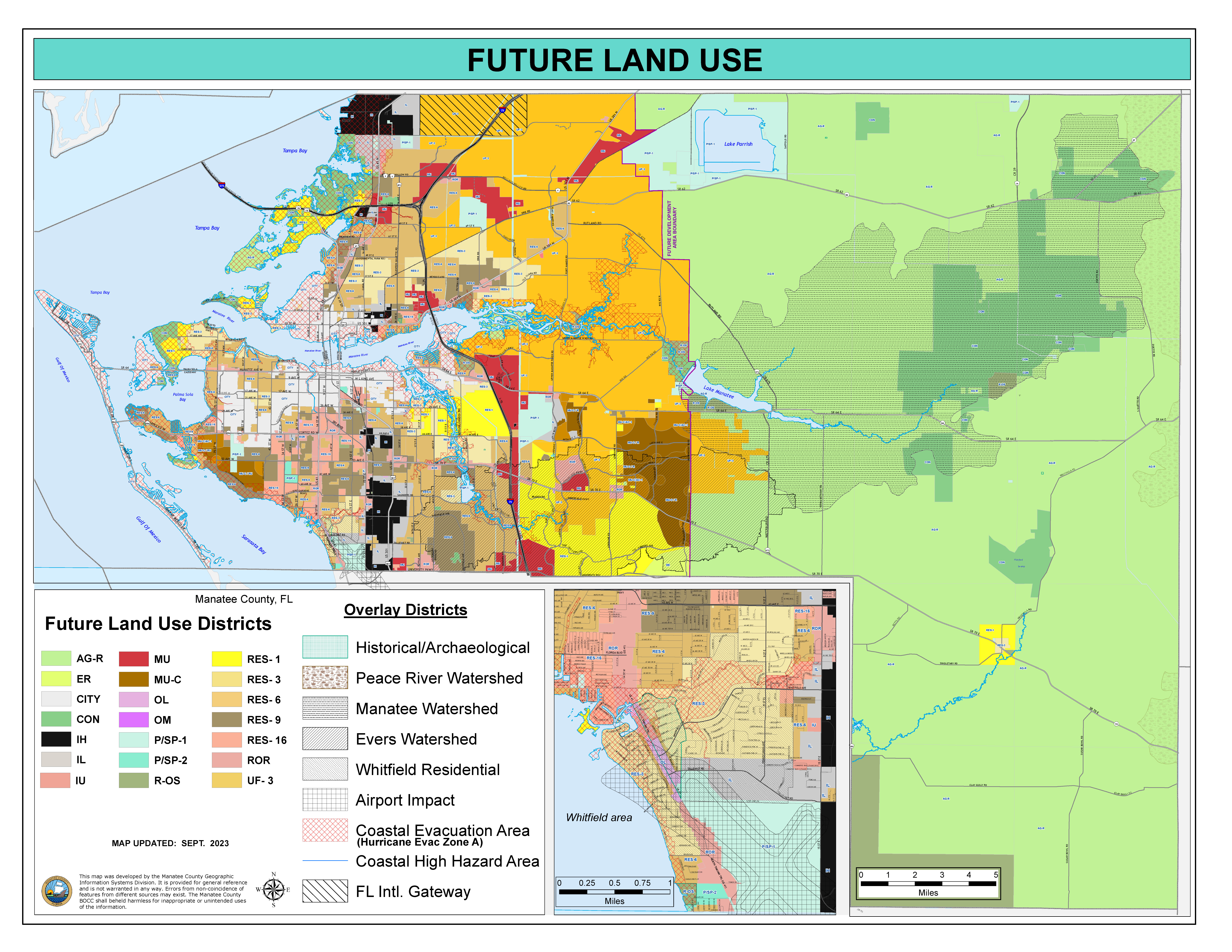Why Manatee County has a Comprehensive Plan
In 1985, Florida was faced with a cultural and legal change of significant proportions. The Florida Legislature revised the Local Government Comprehensive Planning and Development Regulation Act (Chapter 163, Part II, Florida Statutes). All local governments, regardless of size, location or current growth pressures were required to develop and implement a comprehensive plan upon which future land use decisions would be based. The Florida Department of Community Affairs (DCA) had the responsibility to ensure that all of these plans met the basic requirements of the law.
Manatee County adopted its Comprehensive Plan on May 11, 1989 (Ordinance 89-01) which became effective on May 15, 1989. A major revision was adopted on December 16, 1997, renaming it the 2020 Manatee County Comprehensive Plan (Ordinances 97-02 thru 97-06), which became effective on March 9, 1998. Through our Evaluation and Appraisal Report (EAR) process, per PA-06-13/ORD-06-13, the Comprehensive Plan was renamed to the "Manatee County Comprehensive Plan". Numerous amendments have occurred since the effective date, including text, small- and large-scale Future Land Use Map Amendments.
The Comprehensive Plan for Unincorporated Manatee County, though developed in response to the state law, is based on and responds to the unique past, present, and preferred future characteristics of the unincorporated area of Manatee County, and of adjacent local governments.
Other than the purposes expressly defined in Chapter 163, F.S., this Comprehensive Plan has other specific targeted functions, as enumerated in the goals of the various plan elements.
These goals are developed to:
- Improve the physical environment of the community as a setting for human and natural resource activities;
- Protect the public health, safety, and welfare;
- Ensure that long-range considerations are included in the determination of short-range actions;
- Provide for fair and equitable consideration of private property rights while ensuring appropriate protection of the (more broadly-defined) public interest as determined by the Board of County Commissioners of Manatee County;
- Effect political cooperation and technical coordination by bringing professional and technical knowledge to bear on governmental decisions concerning the physical development of the community; and
- To promote a healthy, stable, and vigorous local economy which can satisfy the goods and service needs of the local community, can provide opportunities for economic activity exporting goods and services outside Manatee County, and offer the community an ample range of employment opportunities.
Comprehensive Planning Section
The Comprehensive Planning Section works to protect Manatee County’s long-term public good by analyzing various scenarios and balancing competing interests to achieve community consensus. It updates and maintains the Comprehensive Plan, which outlines long-term policies on land use, transportation, environmental protection, affordable housing, utilities, and more, ensuring short-term decisions align with long-term goals. The plan is reviewed every seven years to reflect changing community needs. This section also analyzes issues such as post-disaster redevelopment, urban development, water supply, school facilities, and land use planning in suburban areas.
View Comprehensive Plan
FLU(Future Land Use) Map and Overlays
Future Land Use Map Series
- Map A - Wetlands Areas (Conservation)
- Map B - General Soils Map (Conservation)
- Map C - Potable Water Well Sites - Wellheads (Water Supply)
- Map D - Regional Spoil Disposal Site
- Map E - Coastal High Hazard Area - (Coastal)
- Map F - Coastal Evacuation Area - (Coastal)
- Map G - UIRA - Urban Infill
- Map H - Urban Core
- Map I - TCEA (14th St W)
- Map J - TCEA (South County)
- Map K - Urban Service Area
Comprehensive Plan Maps (Element Name in Parentheses)
- Airport Noise Contour 1998 (Aviation)
- Antenna Tower Locations (Aviation)
- Beneficial Reuse Area of Evers Reservoir Watershed (Conservation)
- Character Vision Graphic (Land Use Operative Provisions)
- Coastal Planning Area - (Coastal)
- Future Aviation Facilities - Map 5M (Aviation)
- Potable Water / Wastewater Service Areas (Water & Wastewater)
Future Thoroughfare Map 5 Series (Effective Date - 2/25/22):
- Existing Roadways Functional Classification - 5A
- Future Traffic Circulation Functional Classification - 5B
- Future Traffic Circulation Right of Way Protection and Reservation - 5C
- Future Traffic Circulation Number of Lanes - 5D
- Future Traffic Circulation: Designated Controlled Access Facilities - 5E
- Future Traffic Circulation: Strategic Intermodal System (SIS) and Emerging Strategic Intermodal System - 5F
Manatee County Comprehensive Plan Amendments
There are three typical types of amendments which may be initiated by the County or privately:
- Policy (text) amendment (processed as a large scale amendment)
- Large scale map amendment (greater than 50 acres)
- Small scale map amendment (50 acres or less)
Justification for an amendment to the Comprehensive Plan (General Introduction C.2.3.2):
- Shall be considered as a major policy decision by the Board of County Commissioners.
- Shall occur only where it is determined that growth and development patterns and/or goals, objectives and policies initially sought by Manatee County are no longer appropriate.
- How does the amendment benefit the county?
- If proposed amendment is considered a change in circumstances, shall identify what has changed in area to warrant a land use change; development trends; potential impact to surrounding area; land use compatibility issues for the area; justification of “need” for request; etc.
- If an error in mapping (explain how and why)
- If an inconsistency (explain how/why); or an oversight (explain why/how).
- Shall meet requirements of Chapter 163. Florida statutes
Staff requests a meeting with applicant/agent to discuss the proposed amendment on the property. This meeting will give applicant/agent a general idea of issues/ suggestions and/or recommendations regarding the request.
Comprehensive Plan Amendment Process
Expedited Review
The 2011 Legislature approved HB 7207 which modified the Comprehensive Plan amendment process. The Florida Department of Economic Opportunity (DEO) provides an “Expedited Review” [(163.3184(3)] for most plan amendments. A large scale map amendment or text amendment still requires a transmittal hearing and an adoption hearing.
The State and reviewing agencies submit their “comment” letter to the county within 30 days of receipt of a completed amendment package. The adoption of the amendment must be scheduled within 180 days of receipt of the “comment” letter however staff typically schedules the adoption hearing within 30-45 days.
The adopted amendment package is returned to the State Land Planning Agency for consistency review. Once the State deems the amendment package is complete, the amendment becomes effective 31 days from that date.
The Florida Department of Economic Opportunity (DEO) no longer issues an Objection, Recommendation and Comments Report (ORC) under the Expedited Review. There are no more cycles for plan amendments. Amendment requests are processed as received.
Small Scale Amendment
The amendment process for small scale map amendments (50 acres or less) has not changed. The amendment is effective 31 days after adoption by the Board of County Commissioners. A plan amendment package is forwarded to State Land Planning Agency as a courtesy. The State does not review or issue comments on small scale map amendments.
State Coordinated Review
There are only a few instances where an amendment request requires a state review called “State Coordinated Review” [(163.3184(4)]. The State Coordinated Review requires the standard transmittal process, the issuance of an ORC, the County’s response to the ORC, adoption of the amendment, DEO’s final review with the issuance of a Notice of Intent (NOI) before the amendment becomes effective. The types of amendments that must follow the State Coordinated Review are as follows:
Areas of Critical State Concern
- Rural Land Stewardship
- Sector Plans
- EAR based amendments
Map & Text Amendment Lists
Map and text amendments can be found in the Comprehensive Plan.

